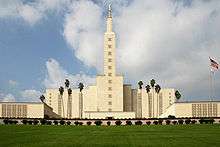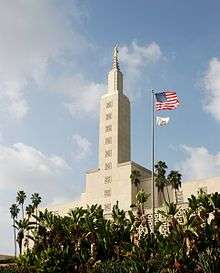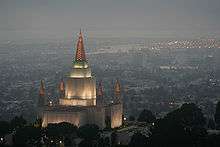The Church of Jesus Christ of Latter-day Saints in California

As of year-end 2011, The Church of Jesus Christ of Latter-day Saints reported 768,344 members in 1,348 wards and branches, 16 missions, and seven temples and 189 Family History Centers in California.[1]
History


Brooklyn Saints
A Mormon immigrant company, under direction of Samuel Brannon, departed on the ship Brooklyn from New York on February 4, 1846 en route to the Great Salt Lake Valley via California. The group under the direction of Brannan navigated around Cape Horn and arrived at Yerba Buena on July 31, 1846. The company of around 230 people were the first known Latter-day Saints to set foot in California. Their numbers nearly tripled the population of the small town of Yerba Buena, later renamed San Francisco. While there, Brannan and other Saints began publication of one of California's first English-language newspapers, the California Star, in October 1846.[2] One of the Brooklyn saints, Angeline Lovett, set up a school in the old Franciscan Dolores Mission, the first English-language school in California.[3]
During the early autumn of 1846, Brannan led 20 men to the San Joaquin Valley where they founded a Mormon farming village named New Hope Colony. It soon failed as heavy seasonal storms flooded the valley, destroying their crops. Most of the Brooklyn saints left California for Salt Lake City in 1848.[2]
Mormon Battalion and California Gold Rush

In January 1847, the Mormon Battalion arrived in San Diego, having constructed the first wagon road across the southwest into Southern California. Battalion Members helped construct a number of building and public works in San Diego. They then traveled to Los Angeles where they built a fort and raised the American flag. Six discharged battalion members were at Sutter's Mill in northern California when gold was discovered there on January 24, 1848. Heading for their families in Utah, they carved the first wagon road over the Sierra Nevadas that would be used by thousands of westward bound travelers including the gold rush "Forty-Niners." Sometimes called the "49er's Highway," it is officially called the Mormon Emigrant - Kit Carson Highway. [4]
In February 1856, George Q. Cannon began publication in San Francisco of the Western Standard, a weekly periodical supportive of the Church.[5]

San Bernardino LDS colony
The first colonization from Utah to California came in 1851 when a company of about 450 saints and slaves under direction of Elders Amasa M. Lyman and Charles C. Rich of the Quorum of the Twelve Apostles settled at what is now San Bernardino. The colony was the final settlement in a string of Mormon communities extending 800 miles (1,300 km) from Salt Lake City in an area known as Deseret. The community thrived, and on July 6, 1851, the San Bernardino Stake, California's first, was organized. The colony was dissolved by the Church at the advance of Johnston's Army toward Salt Lake City in 1857. Brigham Young instructed the settlers to return to Utah to colonize. About 1,400 (fewer than half) returned to Utah at the request of the church. The San Bernardino Stake was dissolved in 1857 as well as the ecclesiastical units within the stake.[2]
Significant Church growth and history 1895-1990
The Los Angeles Branch was created on March 21, 1895.[6] In 1896, the Northern California and Southern California conferences were organized. The Sacramento Conference was added in 1898.[7] Most missionary work around the turn of the century took place in larger population centers.
On January 21, 1923, the Los Angeles Stake became the first stake to be created in the state since the San Bernardino Stake had been dissolved. The Los Angeles Stake was divided on May 22, 1927 to form the Los Angeles and Hollywood Stakes. On July 10, 1927, the San Francisco Stake was established.[8]
On February 18, 1939, 1,400 people visited the Church's exhibit at the opening day of the Golden Gate International Exposition in San Francisco. This exhibit was a visitor's center portraying a reduced-size Salt Lake Tabernacle.
Eight more stakes were created in the 1930s, five in the 1940s and 30 in the 1950s. The completion of the Los Angeles and Oakland Temples soon followed.[8]
President Spencer W. Kimball spoke to members in the Los Angeles area in the Rose Bowl. An estimated 75,000 attended that event.[9]
Recent history 1990-present
At the beginning of the year 2000, California had 17 missions, more than any other state in the United States. In the state's major cities, many minority converts were taught and baptized in their native language. With a significant immigration to California from Latin America, five Spanish-speaking stakes have been organized. Various Asian and Polynesian wards function as well, and a Tonga stake was created in San Francisco in 1992. There are currently more than 200 ethnic wards and branches in California.[8][10]
President Gordon B. Hinckley attended the rededication of the historic Hollywood (now Los Angeles California) Stake Center on June 8, 2003.[11]
Historical reenactments
In July 1996, the sesquicentennial of the arrival of the ship Brooklyn was celebrated through reenactment of the event on a replica ship that sailed into the San Francisco Bay. Members throughout the state commemorated the anniversary with observances that included an exhibit at the San Francisco Maritime Museum,[12] performances of the Mormon Tabernacle Choir at the Davies Symphony Hall,[13] dedications of plaques honoring the early settlers, and pioneer activities and parades.[14]
In addition to commemorating the arrival of early LDS settlers, as well as contributions to the development of the state, members throughout California donated many hours of service in community projects sponsored by wards and stakes, including gathering supplies and food for the needy; cleaning parks, beaches and roadways; painting and repairing homeless shelters, and cleaning up graffiti.
On January 18, 1997, 2,400 members re-enacted the arrival of the Mormon Battalion in California 150 years earlier. Other Mormon Battalion celebrations along the coast followed on respective anniversaries. On March 6, 1997, President Gordon B. Hinckley spoke to a record audience of the Los Angeles World Affairs Council,[15] and on March 19, he addressed the World Forum of Silicon Valley.[16] He also spoke at various Church events during the year. A Church-produced video depicting the discovery of gold at Sutter's Mill was donated to the state of California to be shown continuously at Marshall Gold Discovery State Park in Coloma.
Membership history
Membership growth has slowed in California since 1991 due to significant out-migration of members.
| Year | LDS Membership |
|---|---|
| 1846 | 230 |
| 1920 | 3,800 |
| 1930 | 21,254 |
| 1940 | 44,800 |
| 1950 | 102,000 |
| 1960 | 217,600 |
| 1970 | 349,000 |
| 1980 | 541,000 |
| 1991 | 721,000 |
| 1999 | 740,000 |
| 2008 | 755,747 |
| 2012 | 777,061 |
Disaster relief and humanitarian aid
In times of disasters, such as earthquakes, fires, and floods, members in California have donated countless hours of service, helping communities to recover.
In 1997, members in San Diego donated some 40-50 tons of food to eight community agencies for the homeless and needy.
In May 2003, hundreds of Los Angeles-area Muslims and members of the Pasadena California Stake joined in preparing emergency supplies for Iraqi families. With conflicts of the war with Iraq completed, a humanitarian aid day was set for May 10, 2003, where hygiene kits for some 10,000 families were completed and added to a $650,000 shipment of medical supplies and blankets donated by the Church.[17]
Moral issues
Members in the state have also taken leadership roles in moral issues such as combating pornography and have cooperated with other congregations of various interfaith endeavors. Members have been active in other moral issues including abortion, gaming, drug and alcohol abuse, and marriage.[18]
Missions
The California Mission was opened on July 31, 1846 with Samuel Brannan as president. It was discontinued in 1858 due to the Utah War, but later reopened in 1892 with Luther Dalton who began missionary labors in San Francisco and Oakland. In 1894, Karl G. Maeser relocated to California to direct the Utah exhibit on the California's mid-winter fair and to serve as president of the California Mission.
In January 2015, the church announced that a new California Modesto Mission would be formed on July 1, 2015. It will comprise three stakes from the Fresno Mission and three stakes from the Sacramento Mission. With only six stakes, it will be one of the smallest missions in the United States.[19]
| Mission | Organized |
|---|---|
| California Anaheim Missiona | July 10, 1966 |
| California Arcadia Missionb | July 7, 1969 |
| California Bakersfield Mission | July 2013 |
| California Carlsbad Mission | July 1, 1993 |
| California Fresno Mission | July 1, 1975 |
| California Irvine Mission | July 2013 |
| California Long Beach Mission | July 1, 1998 |
| California Los Angeles Missionc | August 23, 1892 |
| California Oakland/San Francisco Missiond f | July 1, 1969 |
| California Rancho Cucamonga Mission | July 2013 |
| California Riverside Mission | July 1, 1990 |
| California Roseville Mission | July 1, 1993 |
| California Sacramento Missione | January 2, 1942 |
| California Redlands Mission (formerly California San Bernardino Mission) | July 1, 1980 |
| California San Diego Mission | August 1, 1974 |
| California San Fernando Mission | July 1, 1994 |
| California San Jose Mission | July 1, 1978 |
| California Santa Rosa Mission | July 1, 1985 |
| California Ventura Mission | July 1, 1978 |
- Notes
- a California Anaheim Mission - The California South Mission was renamed the California Anaheim Mission on June 20, 1974.
- b California Arcadia Mission - On June 20, 1974, the California East Mission was renamed California Arcadia Mission.
- c California Los Angeles Mission - The California Mission was renamed the California Los Angeles Mission on June 20, 1974.
- d California Oakland Mission - On June 20, 1974, the California Central Mission was renamed California Oakland Mission. On July 1, 2009, it was renamed the California Oakland/San Francisco Mission after consolidation with the California San Francisco Mission.
- e California Sacramento Mission - On January 2, 1942, the Northern California Mission was organized. It was renaimed to the California North mission on July 15, 1966, and ultimately renamed the California Sacramento Mission on June 20, 1974.
- f California San Francisco Mission - On July 1, 1997, the California San Francisco Mission was created. On July 1, 2009, it was consolidated into the California Oakland Mission. The resulting mission was named the California Oakland/San Francisco Mission.
Temples
California currently has 7 temples in operation.
|
|
10. Los Angeles California | ||
|
Location: |
Los Angeles, California, US | ||
|
|
13. Oakland California | ||
|
Location: |
Oakland, California, US | ||
|
|
45. San Diego California | ||
|
Location: |
San Diego, California, US | ||
|
|
78. Fresno California | ||
|
Location: |
Fresno, California, US | ||
|
|
116. Redlands California | ||
|
Location: |
Redlands, California, United States | ||
|
|
122. Newport Beach California | ||
|
Location: |
Newport Beach, California, United States | ||
|
|
123. Sacramento California | ||
|
Location: |
Rancho Cordova, California, United States | ||
Communities
Latter-day Saints had a significant role in establishing and settling communities within the "Mormon Corridor", including the following in California (i.e. in the High Desert (California) region):
See also
- John M. Horner
- Biddy Mason
- Mormon Corridor
- California Proposition 8 (2008)
- State of Deseret
- The Church of Jesus Christ of Latter-day Saints membership statistics (United States)
References
- ↑ "Facts and Statistics". The Church of Jesus Christ of Latter-day Saints. Retrieved October 9, 2012.
- 1 2 3 Warner, Ted J. (1992). "California, Pioneer Settlements in". In Ludlow, Daniel H. Encyclopedia of Mormonism. New York: Macmillan Publishing. pp. 246–248. ISBN 0-02-879602-0. OCLC 24502140.
- ↑ "Every Book . . . Has Been Read Through". The Brooklyn Saints and Harper's Family Library. Lorin K. Hansen.
- ↑ The Discovery of Gold in California, John Sutter, Hutchings' California Magazine, November 1857: The Mormons did not like to leave my mill unfinished, but they got the gold fever like everybody else. After they had made their piles they left for the Great Salt Lake. So long as these people have been employed by me they hav[sic] behaved very well, and were industrious and faithful laborers, and when settling their accounts there was not one of them who was not contented and satisfied.
- ↑ Jenson, Andrew (1941). Encyclopedic History of the Church of Jesus Christ of Latter-Day Saints. Corporation of the President of the Church of Jesus Christ of Latter-Day Saints.
- ↑ "History of the California Los Angeles Mission"
- ↑ "The Church in California". SacLDS.com (blog). November 3, 2005
- 1 2 3 Deseret Morning News 2008 Church Almanac. p 196
- ↑ Robert A. Rees, "Record Number at Southern California Area Conference", Ensign, August 1980, pp. 72–74.
- ↑ LDS Meetinghouse Locator - displays location of wards of with various languages
- ↑ Hubbard, Lincoln (June 14, 2003). "Unique building restored, rededicated: President Hinckley invokes blessing at Los Angeles California Stake Center". Church News
- ↑ Gabriel, Ana (July 6, 1996). "Exhibit honors LDS settlers in California". Church News
- ↑ Avant, Gerry (August 3, 1996). "Opening the 'Golden Gate' with music: Tabernacle Choir performs in honor of pioneer voyage". Church News
- ↑ Gabriel, Ana (August 3, 1996). "1846 seafaring pioneers honored in activities in rustic mission setting". Church News
- ↑ Hart, John L. (March 15, 1997). "Church keeps faith with pioneers". Church News
- ↑ "Global reach of Latter-day Saints". Church News. March 29, 1997
- ↑ Brown, Sonja Eddings (May 17, 2003). "Hygiene kits to help 10,000 Iraqi families: Will supplement LDS shipment of medical supplies, blankets". Church News
- ↑ Public Issues. LDS Newsroom. LDS stance on public and moral issues Archived December 17, 2008, at the Wayback Machine.
- ↑ BREAKING NEWS: Church Approves New LDS Missions
Further reading
- David F. Boone; Robert C. Freeman; Andrew H. Hedges; Richard Neitzel Holzapfel, eds. (1998). Regional Studies in Latter-day Saint Church History: California. Provo, Utah: Department of Church History and Doctrine, Brigham Young University. ISBN 0-8425-2395-2.
- Bagley, Will (Fall 1997). "'Everything is Favorable! And God Is On Our Side': Samuel Brannan and the Conquest of California". Journal of Mormon History. 23 (2): 185–209.
- Baldridge, Kenneth W. (1990). California Mormons: Yerba Buena, New Hope, and Modesto, 1846-1954. Turlock, California: Marietta Pub. Co. ISBN 0934153094. Based on the author's A History of the Mormon Settlement of Central California, with Emphasis on New Hope and San Francisco, 1846-1857, and Modesto, 1920-1954 (M.A. thesis). College of the Pacific. 1956. OCLC 5914081.
- Carmack, John K. (Spring 2009). "California Provided the Answer". Journal of Mormon History. 35 (2): 27–42.
- Cowan, Richard O.; Homer, William E. (1996). California Saints: A 150-Year Legacy in the Golden State. Provo, Utah: Religious Studies Center, Brigham Young University. ISBN 1-5700-8200-6.
- Holland, S. Dennis (1997). Sierra Saints: a brief history of the Mormons in western El Dorado County, 1847-1997. Placerville, California: S.D. Holland Pub. ISBN 0965990400. OCLC 39281684.
- Lyman, Edward Leo (2008). "The Rise and Decline of Mormon San Bernardino". In Neilson, Reid L.; Maffly-Kipp, Laurie F. Proclamation to the People: Nineteenth-century Mormonism and the Pacific Basin Frontier. Salt Lake City: University of Utah Press. pp. 51–73. ISBN 9780874809183.
- Orton, Chad M. (1989). Saints in the Secular City: A History of the Los Angeles Stake (M.A. thesis). Brigham Young University. Based on the author's More Faith Than Fear: The Los Angeles Stake Story. Salt Lake City: Bookcraft. 1987. ISBN 0884946460.
- Owens, Kenneth N. (2004). Gold Rush Saints: California Mormons and the Great Rush for Riches. Kingdom in the West. 7. Spokane, WA: Arthur H. Clark Co. ISBN 0870623362.
- Patton, Annaleone Davis (1961). California Mormons by Sail and Trail. Salt Lake City: Deseret Book. OCLC 1891920.
External links
- LDS Newsroom Facts and Statistics (California)
- The Church of Jesus Christ of Latter-day Saints - Official Site
- The Church of Jesus Christ of Latter-day Saints - Visitors Site




